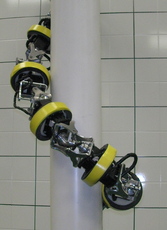Dec 10 2008
The Robotics and Mechanisms Laboratory (RoMeLa) of the College of Engineering at Virginia Tech won the grand prize at the 2008 International Capstone Design Fair with a trio of pole-climbing serpentine robots designed to take the place of construction workers tasked with dangerous jobs such as inspecting high-rises or underwater bridge piers.
 This HyDRAS serpentine robot prototype climbs a pole by converting the oscillating motion of the joints to a whole body rolling motion to climb up pole-like structures
This HyDRAS serpentine robot prototype climbs a pole by converting the oscillating motion of the joints to a whole body rolling motion to climb up pole-like structures
Team RoMeLa scored the cash prize of 1 million won (won is the currency of South Korea) with its robots, the HyDRAS-Ascent (Hyper-redundant Discrete Robotic Articulated Serpentine for climbing), the HyDRAS-Ascent II, and CIRCA (Climbing Inspection Robot with Compressed Air), at the 2008 International Symposium on Educational Excellence 2008 competition.
The event took place at Seoul National University of Technology in South Korea.
The autonomous robots are designed to climb scaffolding and buildings by wrapping around a poll or beam and then rolling upward via an oscillating joint motion. Using built-in sensors and cameras, the robots would then inspect the structures or handle other dangerous tasks now done by humans, said Dennis Hong, director of Virginia Tech’s Robotics and Mechanisms Laboratory and the faculty adviser on the project.
The robots are each roughly three feet in length and use a movement unique even in nature. “These are really wicked cool robots,” he added.
The need for autonomous tools in the construction field is great. Hong cites a 2006 U.S. Bureau of Labor Statistics report that tracked the workplace deaths of 1,226 construction workers in 2006, an increase of 3 percent from 2005. The same report listed 809 deaths as a result of falls from raised structures such as scaffolding, Hong said.
“Unlike inchworm type gaits often being developed for serpentine robot locomotion, this novel climbing gait requires the serpentine robot to wrap around the structure in a helical shape, and twist its whole body to climb or descend by rolling up or down the structure,” Hong said.
The HyDRAS robots operate using electric motors, while the CIRCA robot uses a compressed air muscle. “The use of compressed air makes this approach feasible by enabling it to be light weight, providing compliant actuation force for generating the gripping force for traction, and allowing it to use a simple discrete control scheme to activate the muscles in a predetermined sequence,” Hong said. For now, the robots operate by a tethered wire attached to a laptop, but Hong and his students are reconfiguring the devices to function independently using an onboard microprocessor and power source.
“This family of novel robots will serve as a practical inspection tool for construction sites without putting workers in harm’s way,” he added.
The robots were developed by mechanical engineering students Gabriel Goldman of Richmond, Va., and Nick Thayer of Poquoson, Va., who are both currently pursuing mechanical engineering doctoral degrees at Virginia Tech. The remaining student developers, all of which are recent graduates, are Michael Bloom, Florian Böss, Cory Kaser, Vic Kassoff, David McDowell, Spencer Patton, and Jeff Philis.
Goldman and Thayer traveled to Seoul with the robots to display and present the team’s work at the international symposium. Universities from more than 15 countries submitted 44 entries, according to Hong, who remained in Blacksburg during the event. The prize of 1 million won, the currency of South Korea, prize equals roughly $690 U.S. Korea currency rates have been hard hit by recent worldwide economic woes and are now at half their normal power, Hong said.
“There was a lot of great talent in that room and everybody brought back some good experiences,” said Thayer.
“Being able to compete against so many other great projects from around the globe and be recognized like that is truly an amazing feeling,” said Goldman.
The award was based on display and technical presentation, Hong says. Goldman and Thayer showed video of the robots climbing polls at the RoMeLa lab in Blacksburg, while the actual robots slithered horizontally on the floor. The event’s location did not allow the graduate students to demonstrate the robot’s vertical climb capabilities.
The robots debuted this past spring and already have won several awards, including CIRCA taking first place with a cash award of $10,500 for the 2008 CAGI Innovation Award conducted by the Compressed Air and Gas Institute, and HyDRAS winning second place with a cash award of $2,500 at the 2008 ASME Student Safety Engineering Design Competition.
Hong has overseen several other award-winning student RoMeLa teams in the area of robotics, including TEAM DARwIn for RoboCup 2007, an international autonomous robot soccer competition. The group was the first and only team from the United States ever to qualify for the RoboCup humanoid division.
Additionally, a team of students won third place with a cash award of $500,000 for the 2007 DARPA Urban Challenge, an autonomous vehicle race in the urban environment, where he served as the co-team leader. Last year he received $20,000 to continue his work in humanoid robotics from the Virginia Tech Student Engineers' Council.
Hong is a National Science Foundation CAREER Award recipient. He received his bachelor of science degree in mechanical engineering from the University of Wisconsin-Madison in 1994, and his master of science and Ph.D. degrees in mechanical engineering from Purdue University in 1999 and 2002, respectively.